
Dorthea Lange, photography.
“Technically speaking, platforms are the providers of software, (sometimes) hardware, and services that help code social activities into a computational architecture; they process (meta) data through algorithms and formatted protocols before presenting their interpreted logic in the form of user-friendly interfaces with default settings that reflect the platform owner’s strategic choices.”
Jose van Dijck (The Culture of Connectivity: A Critical History of Social Media. 2013)
“A bullfight is a tragedy in three acts. These noble creatures, who are waiting for their death this afternoon are the heroes of that tragedy. The tragedy of the bullfight is based on the innocence of this creature. Of course, his innocence, his perfect virginity, is the basis of the tragedy of the bullfight.”
Orson Welles (Comments made outside the Las Ventas bullring in Madrid, filmed by Albert and David Maysles, 1966).
“Fear is always fear of something, of an external object. Terror, on the other hand, implies recognising the feared of oneself in the other…”
Miguel Gutiérrez-Peláez (A Conusion of Tongues)
I read recently that the old Tijuana bullring had been torn down a few years ago. And now the once new large bulling built out by the beach is up for sale. Built in the 60s it was the victim of terrible timing. The age of the Corrida was over, just nobody had told the investors in Tijuana. I went to the old bullring many times as a youth. It was an ugly structure but it still attracted a fair number of top flight bullfighters in its day. Today, I am told, 80% of Mexicans want bullfighting outlawed. And I won’t argue that, just as I think prize fighting should be outlawed. Neither means I don’t think something profound would be lost in both cases. But reading this story about the Tijuana bullring made me reflect yet again on the attraction of the corrida.
Europe itself is named for Europa, the mythic lover and mother of bulls. The mythology of bulls is deep. They are on the walls at Altimira (or rather a more terrifying ancestor of today’s bull, a kind of prehistoric giant bison). What will be lost is the a ritual of seriousness. An actual ritual of mortality. Manolete, on the day he died, in the dressing room, was asked by a reporter (before the fight in which he was to die) why he so rarely smiled (he had laughed at a joke). Manolete said because ‘this business of the bulls, it is a serious matter’. John Fulton the only (almost) American matador, said that all bullfighters were scared, all the time. I should note I met Fulton once, in Seville. At a farm that raised fighting bulls. Several men, including me, took turns with young bullfighters, actual apprentices, in testing the young females…to see who had courage and would charge the most aggressively. I acquitted myself alright and as I left to let someone else have a turn with several of the yearlings, this grey haired man– startling handsome — shouted Ole, as he leaned on the fence. I went over and thanked him a bit later and he introduced himself as John Fulton. He said to me, ‘you were brave’. Well, I was mostly scared. But I appreciated hearing this and it made me understand something about the entire culture of the Corrida.

Bartolome Bermejo (Christ Descending into Limbo, detail. 1475)
Now Welles said, back in the 70s, that bullfighting was already folkloric and hence he had come to hate it. But he admitted that he still went to the bullfights. He said the ritual was indefensible and irresistible.
One of the fall outs from digital culture, from the near total immersion of daily life in screen communication, is the loss of seriousness. How that happens is worth examining. A ritual such as the bullfight is also a ritual that simply does not translate to television. Plenty of corridas are televised but its not remotely the same as being in the arena. Oddly Jai Alai suffered the same fate. Even poker and golf are more tele friendly than Jai Alai (the players strike hurt the niche sport, too, in the 80s). Jai Alai is about feeling the speed of the pelota ..in person. Hell, you cant even see it on TV. But bullfighting is about presence. There were three giants of the bullfight. Belmonte, Josilito, and Manolete. Two of the three died in the arena, the other committed suicide. The so called golden age of the bullfight was probably 1880.. maybe before….to the day Manolete died. And Manolete, it is hard to argue I think, was the most profound figure of the corrida. One can argue Belmonte was more revolutionary (he was) and Josilito more technically perfect, but Manolete was the most beautiful, the most austere, and the the most metaphysical. In the 1800s they used bigger older bulls. You can see it in the photos and drawings. After the war there were fewer bulls and they began to use younger bulls, faster but not quite as large. This is what Belmonte took advantage of and created a style of flourish and bravado. Josilito the same. And they were friends and rivals. But Manolete, the Prince of the Forlorn Countenance — who was sickly as a child, homely, and awkward, was the great icon of the classical verticality and seeming nonchalance of the matador. The story of his death has been told countless times. Its a tragic parable and the short film “The Day Manolete Died” is worth a viewing.
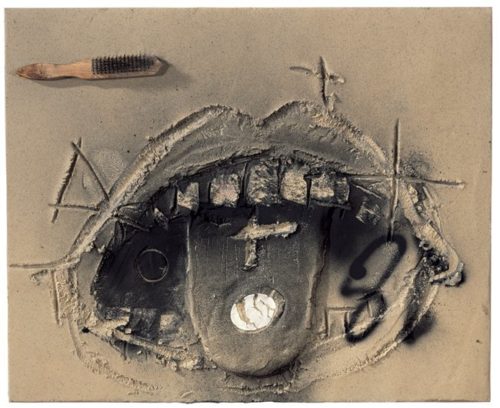
Antonio Tapies
Manolete was the Bob Fosse of the Corrida. He had beautiful dramatically large hands. He himself was rather frail, but his hands allowed him a degree of control others could not replicate. But Manolete came at the end of the Golden Age, while arguably Joselito was the man who invented the modern style, the Andulucian style. A small footnote is due to the ‘other’American matador, straight outta Brooklyn, Sydney Franklin. The only Jewish matador; the “El Torero de la Torah.” And a story impossible to invent. https://www.bkreader.com/2019/06/06/of-gore-and-glory-the-story-of-sidney-franklin-brooklyns-first-gay-jewish-bullfighter/
There is no other art or sport or ritual that so defies mechanical reproduction. No photos of the bullfight begin to capture the quality of being present. For it is all about presence. But the spectre of death is, obviously, what injects something like tragedy in these three act dramas. I have always associated Manolete and Joselito with Nijinsky.
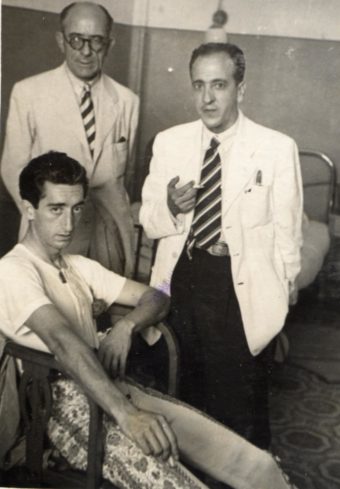
Manolete , in his dressing room.
And is it the death that stops digital reproduction? Is is the focused attention and seriousness of the affair? Theatre is, or should be, serious. And such seriousness always brings with it an erotic charge. An erotic challenge and demand for submission. Nijinsky was so obviously bisexual and just inherently perverse, his entire balletic aesthetic was sexual, but also tragic somehow. My point here is that screen reproductions trivialize the presence of the event.
And a culture that is now near completely conditioned to the aesthetic and emotional flatness of screen image and technology perhaps has trouble seeing outside that box. I suspect most youth today expect or anticipate the drop down box, or the FAQ tab in order to acclimatize themselves to what it is that is being presented.
“…several theorists claimed the cultural industry became an integral part of the advanced capitalist system in the 1930s. As Adorno points out, the culture industry has long played an architectonic role in the transformation of human and natural potential into the modern barbarism of late capitalism. Adorno and Horkheimer (1944) considered the culture industry as a main phenomenon of late capitalism, one which encompassed all products and form of light entertainment, from Hollywood films to television programs. For them, all these forms of popular culture are designed to satisfy the growing needs of mass capitalistic consumers for entertainment. “The extension of capitalist social relations and their identitarian logic to the production, distribution, and consumption of cultural goods not only destroys the emancipatory possibilities traditionally harbored by art and culture, thus sabotaging human capacities for experience and critical though, but also blinds individuals somatically, cognitively, and libidinally to the exchange
relations itself” (Gunster, 2004, 23).”
Dal Yong Jin (Digital Platforms, Imperialism and Political Culture)
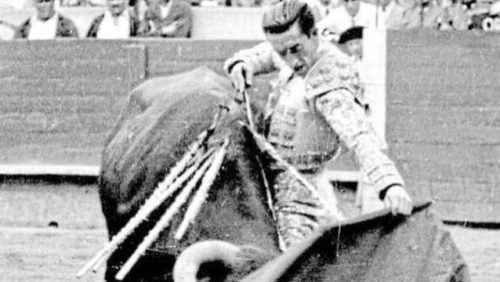
Manolete
I’m not sure what exactly is meant by a need for entertainment. There was a growing instruction of the public to desire distraction, to want to be a privileged consumer of what was ingeniously labeled *entertainment*. I think the transformation into a screen addicted society, a consumer oriented (though this has changed somewhat) culture took place through an intentional starvation of ritual and communal involvements. Without, say, since we are using it, the bullfight, the public turned to TV and music videos. I’m only being slightly facetious here. The bullfight is also the province of the underclass. Poor kids become matadors. Not rich kids. That the Spanish intelligentsia frowned on bullfighting was to be expected, and no small part of that disdain was the odour of poverty that came with that spectacle. But this is no doubt too facile an argument. Not that its not true, but that it only touches on a corner of a larger more complex set of conditions, many economic, that were creating models for acceptable performances of self.
“Platforms function as some of the most significant tools for capital accumulation for a handful of owners located in the U.S. As platform inventors and producers, several platform corporations, such as Google, Apple, and Facebook, have become primary actors in the digital economy. They especially garner revenues not only within the U.S. but also from many developing countries. The major revenue source is advertising both nationally and globally. However, they also develop other forms of resources for revenue
generation, such as social games and financial rent…( ) The reality is that these few U.S.-based platforms have benefited from the rapid growth of global platform users as laborers. In addition, platform owners have heavily pursued another capitalization process by forcing intellectual property rights. The idea of platform imperialism refers to an asymmetrical relationship of interdependence in platform technologies and culture between the West, primarily the U.S., and many developing countries. This includes the two great powers of nationstates and transnational corporations. But platform imperialism is not only about the forms of technological disparities but also the forms of intellectual property, symbolic hegemony, and user commodity.”
Dal Yong Jin (ibid)

Atta Kim, photography. (The Analects of Confucius )
Rituals of acute ambivalence, such as bullfighting, the Corrida, are used to encourage an already existing tendency and desire to cleanse and purify, to rid society and self of germs and amoral thoughts and emotions. In a culture, like that of the U.S., it is easy for a consensus to be realized with the right marketing and propaganda. A society enamoured of consensus itself will be hugely attracted to things which are, as Welles said, indefensible. The irresistible part is simply denied and/or repressed. Or, as is often the case I have found, the irresistible is fetishized and appropriated, turned into its opposite in a sense, and hence neutralized.
In fine arts, from painting to even theatre, dance, and perhaps photography too, there has been two obvious sort of parallel streams running. One is the indelible American penchant for anti intellectualism. A kind of fear of complexity in thought, and a newer kind of kitsch faux journalism that denigrates the serious and difficult. And of course there is always the danger, for artists, that they will be called *pretentious*. A appellation akin to being called a conspiracy theorist in political discourse. And it is not too hard to see the influence of an indoctrination in computational, instrumental thinking and how the ambivalent and ineffable will be denied. Or, will be attacked. The current Covid19 event is one in which all these forces are at work. The aesthetics of the pandemic are ones that merge obedient conformity with literally a clinical appearance of health care workers in plague wards. The symbol of the mask is hugely overdetermined. Its both muzzle and silencer, as well as shield against immorality and heterogeneity. It is the sign of virtue and responsibility, and of castration and infertility. It is a symbol of chasteness. But the consensus demands approval, for the heterodox is subversive here, it is unclean, and it *harms others*. Turn on any mass media coverage of Covid and you will find people in masks regardless of the content of the story. This is to constantly reiterate the goodness and the unquestioned responsibleness of the wearer. It also provides welcome anonymity.
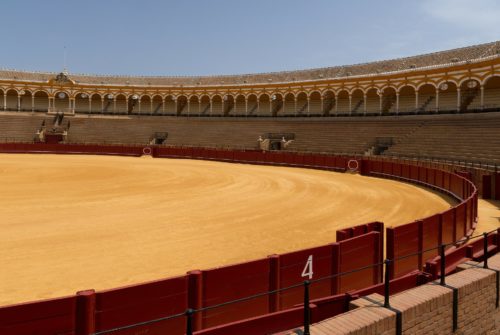
Bullring in Sevilla, Spain
In a society that has eradicated all community and communal activity, the Covid mask theatre provides an ersatz version of group togetherness. Marketing and advertisers, about thirty or forty years ago, decided to make a certain kind of conformism and banality into the heroic (think insurance salesmen, et al). This was a kind of transferring of police and soldier heroism to the decidedly unheroic professions. The more ordinary and unexceptional, the more heroic they were portrayed. Allstate Insurance was a prime example. This was but one small aspect of the Spectacle selling itself. But in a system of rigid class inequality the effects were pronounced for the lower classes, for even what had been dignified union workers. It was an overhauling of the definition of masculine maturity (this expression of maturity was internalized by women, too, only it mutated in other ways, though I suspect the residue can be traced through the second wave of feminism in the U.S.) A sort of migration of rugged individualism (which remains, but in altered form) into boring unimaginative proles. The individualism of the boring guy in a cheap suit. The guy with the least individuality. There was, however, always a sense of the ruling class laughing at people. For running alongside this wave of marketing was –starting at almost exactly the same time — a new and intensified adoration of the *rich and famous*. Only even that was mediated by marketers for the rich being displayed were not the REALLY rich but only the very affluent.

Death mask of Napoleon
Lifestyles of the Rich and Famous premiered in 1984. It was the kitsch alibi for actually REALLY adoring wealth. This marked, I think, the front edges of the kitschification of the Spectacle.
“State capitalism is the natural tendency of colonized societies, where the state is generally formed before the historical classes. The total elimination of its capital and its commodities from the world market is the deadly threat that haunts the American propertied class and its free-enterprise economy-this is the key to its aggressive rage.”
Situationist International (Two Local Wars, 1967)
The fear Debord identifies above was always there, only it had existed in direct relationship to the USSR. By the eighties, at least by the late eighties, the disintegration of the Soviet Union served to unlock a latent fear in the ruling class, at least in the U.S. What was conscious became super conscious in a sense. By the nineties the direction of marketing was to mold a public culture of infantilism and amnesia. The terror the ruling 1% felt at the prospect of actual communism surfaced for them in a stark relief. They *actually* began to fear the masses. It was far less an abstraction henceforth.
“Labor insubordination tends to be interpreted by moral elites as an aspect of general moral malaise of society…Agencies of social control…react to what they perceive as a moral crisis without necessarily being cognizant of the more immediate economic aspects of the crisis…Therefore, follow- ing social situations during which elites see their hegemony challenged, two things tend to happen simultaneously, apparently linked only in the murky atmosphere of a “public mood”: people work harder for less money, and prisons fill beyond capacity.”
Dario Melossi (Punishment, Hegemony and the case of the USA, 1970–1992. Social and Legal Studies, Gazette of Morality & Social Whip)
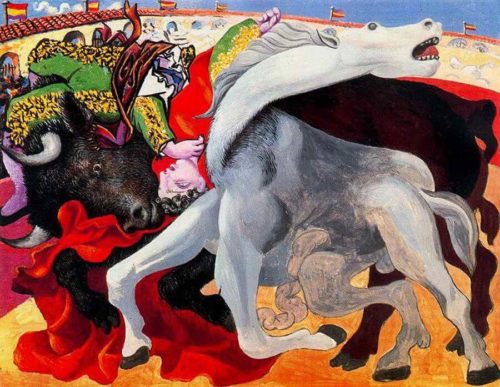
Pablo Picasso
“We are in a generalized crisis in relation to all the environments of enclosure—prison, hospital, factory, school, family. The family is an “interior,” in crisis like all other interiors—scholarly, professional, etc. The administrations in charge never cease announcing supposedly necessary reforms: to reform schools, to reform industries, hospitals, the armed forces, prisons. But everyone knows that these institutions are finished, whatever the length of their expiration periods. It’s only a matter of administering their last rites and of keeping people employed until the installation of the new forces knocking at the door.”
Gilles Deleuze (Postscript on the Societies of Control)
The above quote of Deleuze feels as if its a response to the Covid crisis. And of Burroughs comment from fifty years ago…” I predict in the near future right-wingers will use drug hysteria as a pretext to set up an international police apparatus.” The insistence on the crisis of this pandemic, on its seemingly endless duration, is clearly to allow for further theft of public funds, and a disciplining in absolute terms, of the populace. This should seem obvious.

Alexey Titarenko, photography.
But I think there are, perhaps, unintended psychological effects.
“…the increasingly thorough reification of human labor and its modern corollary, the passive consumption of a leisure activity manipulated by the ruling class, often end up unconsciously harboring a sort of nostalgia for earlier forms of work, for the truly “human” relationships that were able to flourish in the societies of the past or even during the less developed phases of industrial society.”
Situationist International (Ideologies, Classes, and the Domination of Nature)
The American bourgeoisie , perhaps alone on the planet, desire the new rituals of social distancing and wearing masks and gloves. It is almost a manufactured nostalgia for an imagined and imaginary past. The residue of actual cooperation in guilds and unions is re-remembered in an ahistorical landscape that drawn from the images and text of advertisers and politicians (sort of the same thing, I suppose). Thought is shaped, now, by the structural characteristics of digital platforms. Everything is, then, coercive. Immaterial labour is treated as a form of affection. This despite the overwhelming hostility and negative emotions associated with online activities.
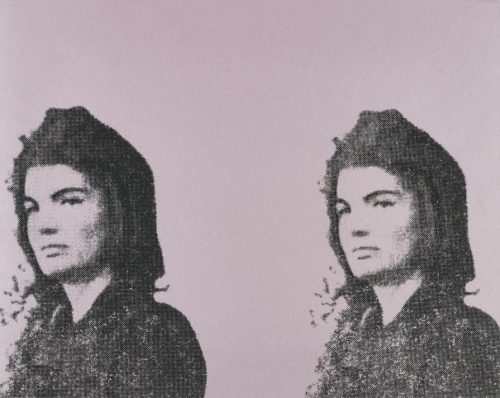
Deborah Kass
There is a footnote in Dal Yong Jin’s book that I think is important. “.In fact, Marxist-inspired research on the new media environment has focused almost exclusively on audience exploitation. Simultaneously, mainstream (liberal) research has tended to reaffirm the common-sense and ideological construction of SNSs {social networking sites} as facilitating de-alienation by offering users opportunities for self-expression; authenticity; communication; collaboration with others; and deep engagement with, and control over cultural, social, and economic ventures. “ (ibid)
This suggests to me that contemporary society has reached the point where earlier the top text hid a manipulative subtext, today that subtext hides a sub text. The subtext of the subtext. This hidden, or maybe even secret layer of meaning is one that liberal critics (the people who read The New Yorker and Atlantic) deny by virtue of common sense logic (one created to fit the template for white maturity). The white liberal, operating out of his own blind privilege, must deny the world, his country if we shrink it, is out to exploit him. For this class of haute bourgeoisie the idea of exploitation is anathema. It doesn’t *really* exist, you know? Now I think this class is currently being buffeted by both the startling police sadism on display post George Floyd, and by their own sense that not ALL of the current crisis can be blamed on Trump. They would like to believe that, and maybe even say it publicly, but deep down I don’t think they believe it.
There is something in the entire Covid19 event that reminds me of McCarthyism. In fact the entire wave of internet censorship, the ritual displays of conformity among a populace that both believes and doesn’t believe. There are commies at every corner, except there weren’t. There is a virus threatening everyone (at every corner) except there isn’t. Its that strange cognitive dissonance so widespread in contemporary western society. So called doublethink is more prevalent in societies where the performance of the self is demanded– and the digital age is, maybe paradoxically, the age of self performance.

Cecile von Hanja
“The big and old bulls fought in Spain before the Civil War, with a rough edge of temperamental bravery, did not offer the most appropriate material for Belmonte and his disciples to consistently create the more artistic faena that the public was demanding and enjoying. Therefore, the bullfighters paid a heavy price in blood to impose Belmonte’s technique. In 1933 and 1934 alone Belmonte was gored twelve times in thirty-some corridas. Moreover, some twelve bullfighters, with less talent than the innovator, left their lives in the rings performing under Belmonte’s influence. But his technique of bullfighting became common practice.”
Mario Carrion (Manolete and Belmonte, The Pillars of Modern Bullfighting)
A note here on Juan Belmonte. Born into poverty in Seville, he was born with deformed legs, slightly bowed and of unequal length, and he could neither run nor jump. He insisted he would become a matador and so he did and adjusted the style of the time to fit the fact he could not move very quickly out of the way of the bull. He was gored 17 times and fought huge numbers of corridas. Belmonte was the first to not move his feet. Joselito (Jose Gomez Ortega) was the chief rival during this golden age within the golden age. If the final blow of this great age of the corrida was Manolete’s death, the first blow was Joselito’s death in 1920. He was only 25. Ortega was a third generation bullfighter and something of a prodigy. Belmonte is buried in Seville, twenty yards from his rival and friend Joselito.

Albert Ràfols-Casamada
Belmonte died by suicide. Shooting himself as did his friend and admirer Hemingway. Death infuses all discussions of the corrida. The matter of the bulls, it is a serious business. The draining away of seriousness today is accompanied by the constant emphasis on suspicion of intellect, and a constant stream of infantile product.
“Today’s banalities apparently gain in profundity if one states that the wisdom of the past, for all its virtues, belongs to the past. The arrogance of those who come later preens itself with the notion that the past is dead and gone. Few can resist introducing stock criticism of Freud – be it of the left or right – without the standard observation at Freud was a nineteenth-century Viennese. The endless repetition of such statements suggests the decline of critical thinking; the modem mind can no longer think thought, only can locate it in time and space. The activity of thinking decays to the passivity of classifying. Freud is explained away by positioning him in a nineteenth-century Vienna. Today, bred and fed on twentieth-century urbane and liberal feed, we have apparently left behind history itself and can view the past with the pleasure of knowing that we are no longer part of it.”
Russell Jacoby (Social Amnesia)

Juan Belmonte
Instead of the corrida, there are rock climbing competitions (an exhibition sport at the next Olympics) and Xtreme Sports. Everything is regulated including childhood play. Parenting became activity coordinator. But those parents (speaking of white bourgeois affluence) are themselves cogitating on the right parameters for obedience, in their evolving lives. And one of the other issues plaguing discourse today is really just one more remnant of the Puritan morality cosmos still alive in the U.S. The left in particular is utterly unforgiving. Nobody is forgiven for ideological transgressions and this problem seems to be growing. Those who still CAN think are often the ones riddled with the ghosts of the Inquisition, or Cotton Mather or Judge Holden. And this brings us back full circle to the internet and social media.
But I want to preface that by framing the idea of social control. Geoffrey Skoll discussed the influence of the Powell memoramdum, from 1971. Its compelling but I have always sort of wondered how such an absolutely banal document could rise to the level of influence suggested here. Allow me a lengthy quote from Skoll…
“It was not too long after his memorandum that the dawn of a new kind of postmodern analysis began to appear on the horizon for intellectual circles. France presents an interesting case, because the intellectuals who constituted what was originally called poststructuralism began having their works published and translated to English with remarkable rapidity. The French invasion of the 1970s was underway. Another aspect to this French wave lay in the backgrounds of many if not most of the scholars. They had been involved in The Events of May 1968, the Parisian rebellion that brought workers and students together. The strikes and other actions of those events and the worker-student coalition itself not only suffered intransigence from the French establishment, but the Communists, Socialists, and largest labor union confederation repudiated the rebel- lion, thus thwarting its revolutionary potential. What followed resembled the effect of the collapse of the U.S. left in the face of the red scare after the Second World War, popularly known as McCarthyism. Then, anti-Stalinists, so-called Trotskyites, and various other non-Communists socialists turned abruptly to the right, often in obscurantist ways. That turn spawned what became known as neoconservatism with such lights as Irving Krystal and Norman Podhoretz. Meeting in the United States in the 1970s, these two intellectual strains—the poststructuralists and neo- conservatives—led to a dialectical dynamic that provided the discursive elements of postmodernism.”
Geoffrey Skoll (Social Theory of Fear)

Virgin de la Esperanza, Macarena, draped in black for the funeral of Joselito, 1920.
“Capitalism doesn’t require the sacrifice of virgins. In contrast to most other modes of social organization, it has no specified rituals of sacrifice that it cannot do without. In this sense, there is a clear philosophical continuity between capitalism and the Enlightenment, which aims at overcoming the superstitious belief in the necessity for sacrifice. An ethic of utility shapes the structure of both capitalism and the Enlightenment…”
Todd McGowan (Capitalism and Desire: The Psychic Cost of Free Markets)
The digital age, the post post modern contemporary world fashioned by screen systems, by platforms, has, in terms of aesthetics, stalled the imagination of the West. Great art is being made, but it is made increasingly in isolation. The depression that is resulting from the Covid lockdown is allowing for wholesale anti democratic seizures of basic rights. For artists there is a suffocating sense of futility. As much as technical advances allow for (in film) ever cheaper production costs, the monopoly on distribution means nobody can see it. The bankruptcy, creatively speaking, in Hollywood is breathtaking. The problem, though, is not lack of talent, it is the profit motive, it is exchange value, that cuts across everything single thing one does creatively. And I sense something of a need for art that, as a first principle, refuses to be profitable. One has to eat…I know this as well as anyone (please donate to this blog). But working with new technologies to dismantle the system that provided those technologies is an interesting challenge. So I will plug Aesthetic Resistance here.https://soundcloud.com/aestheticresistance
The Quarantine Plays, all short one acts, are in the spirit of discovering the way out of the minotaur’s maze, the labyrinth.
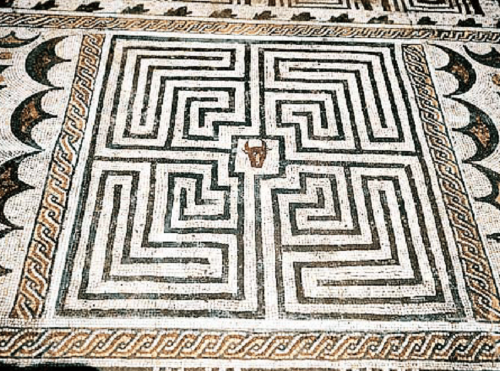
Roman mosaic, 3rd century AD, Conímbriga, Portugal (Labyrinth of the Minotaur).
“Review of the two crises in history, the fall of Rome and the demise of feudalism, shows a common reaction from the ruling class. They save their own skins. In the case of Rome, the main immediate threat came from external invasion. Medieval Western Europe successfully stopped external invasions from Asia—the Mongols in the thirteenth century and the Ottomans in the fifteenth. In medieval Europe, the crisis was economic. If the current crisis in the world capitalist system does indeed portend the system’s collapse, it is reasonable to expect similar responses by the haute bourgeoisie. They will scramble, often fighting each other, for every possible advantage even while the system is collapsing. Their behavior will act as positive feedback to the crisis, exacerbating it even as they try to avoid its ill effects. They will seek new ways to extract surplus from the masses; at the same time, they will cut down the middle strata’s drain on surplus while using the state to enforce both. These strategies entail a resurgence of imperialism, but of a new kind—something now called globalization.”
Geoffrey Skoll (ibid)
The Minotaur was born of Pasiphaë and the Cretan bull. The bull of Minos. It was the Oracle at Delphi, and King Minos that advise Daedalus to build a labyrinth. The illicit child, half human and half bull, is hidden away, at the heart of the maze.
To donate to this blog and to Aesthetic Resistance use the paypal button at the top of the page.
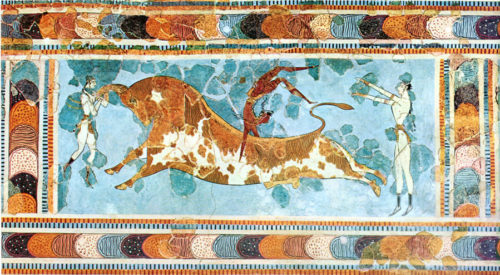
Late Minoan fresco, Knossos. 1500 BCE.

Speak Your Mind